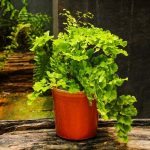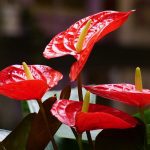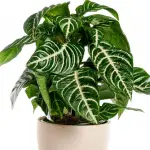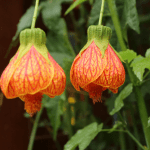
Emerald fern (Asparagus aethiopicus) is not actually a fern, but more closely related to asparagus – the popular vegetable. Also known as asparagus fern or Sprengeri fern, this plant’s graceful, feathery foliage makes it look very fern-like.
Emerald Fern Care
Emerald ferns can be challenging to grow indoors. Although they are low-maintenance and drought-tolerant due to their tuberous roots, they also require constantly high humidity. This makes them tricky to keep happy in dry indoor environments. Here’s a rundown of basic care guidelines:
- WATER: Moderate
- HUMIDITY: High
- FEEDING: Once monthly spring – fall
- LIGHT: Bright, indirect
- TEMPERATURE: 60 – 80 degrees F (15 – 26 degrees C)
- SAFETY: Toxic to humans and pets
- DIFFICULTY: Challenging
Keep reading for more detailed information on caring for this beautiful houseplant, including tips for fertilizing, potting, maintenance and troubleshooting.
Water
Emerald fern needs moderate water due to its thick, tuberous roots that do a good job storing water. During spring through fall, water when the top 1 inch of potting soil dries out. (Insert your finger in the soil to about the first knuckle. If it feels dry, the plant needs a drink.)
During the winter, wait until the potting soil becomes dry to a depth of 2 inches. This plant needs less water during the winter season when it’s not actively growing. But make sure you never allow the soil to dry out completely, and never allow the plant to stand in water either.
Humidity
This fern prefers high humidity levels. Mist daily with a spray bottle of lukewarm water set to the mist setting, or use an electric plant mister. You can also place the fern on a tray filled with pebbles and water (see my post on how to make a humidity tray for more information).
And finally, I recommend placing this plant in a room with a high quality houseplant humidifier. This is especially important if you live in a dry climate like I do. See my favorite houseplant humidifier review (the one I’m using right now), or click here to view it directly on Amazon.
It’s also a good idea to group emerald fern with other plants that like high humidity. This makes it easier to keep the air moist for all of them. This plant will thrive in a brightly-lit bathroom.
Fertilizer
Feed once a month during spring through fall using any high-quality houseplant fertilizer. My favorite fertilizer for foliage plants and ferns is JR Peters Houseplant Special. You can read about why I love this brand of fertilizer so much on this page (and check out the Amazon reviews).
To prevent burning, dilute the fertilizer to half strength – and remember to apply only once a month. Emerald fern is not a heavy feeder, so it doesn’t need much. Do not feed during winter when the fern is not actively growing.
Light
Emerald fern likes bright, indirect or filtered light. Avoid the hot afternoon sun, as this can cause the delicate leaves to turn yellow. The ideal location is an east-facing window, or a west-facing window with the light filtered by a sheer curtain. A north-facing window will not provide enough light, and a south-facing window might be too much.
Temperature
Ideal temperatures for emerald fern are 70 to 80 degrees F (21 to 26 degrees C) during the day, with nighttime temperatures of 60 to 70 degrees F (15 to 21 degrees C). It can withstand temperatures as low as 45 degrees F (7 degrees C), but not for long periods.
Emerald fern loves warm temperatures, but try to keep things consistent. Do not place near drafts from opening doors or blasts of heat from heating vents.
Potting
Pot emerald fern in any well-draining, all-purpose potting soil formulated for houseplants. My favorite is this one by Happy Frog because it contains mycorrhizal fungi and beneficial soil microbes, but any high-quality potting mix you like will work.
When your fern outgrows its container, shift to a pot with a diameter at least 2 inches larger than the current one. (It prefers being slightly root-bound.) Re-pot in spring after pruning off any old stems. Due to its cascading growth, emerald fern looks lovely in hanging baskets.
Propagation
Emerald fern is easy to propagate by division. When dividing, make sure each individual division has several of the tuberous roots attached. It’s best to divide in spring when you’re already planning on re-potting the plant.
Maintenance
This fern is very low-maintenance, but you may need to trim away yellowing stems from time to time. To keep your plant healthy, snip off yellowing stems at the base. This stimulates new stems to grow from the root system.
Troubleshooting
Here are some common issues indoor gardeners often have with emerald fern (and how to fix them):
- Yellowing Leaves – If the leaves of your emerald fern are turning yellow, the temperature is too high, light is too bright, or your plant may be over- or under-watered. Some yellowing of leaves at the base of the plant is normal. If you see yellowing elsewhere, try moving to a cooler location, place in a slightly shadier spot, and/or make sure you’re watering only when the top 1-inch of soil dries out.
- Brown Edges on Leaves – If you notice brown edges on your emerald fern leaves, this means it’s had too much sun or the potting soil has dried out. Move to a shadier location with bright, indirect light (but not direct sun). Water well and allow excess to drain away. If your fern is severely under-watered, see my post on how to revive under watered plants.
Related Questions
Here are some related questions readers ask about emerald fern and caring for ferns in general (plus my answers).
How do you Take Care of Emerald Ferns?
Place in a location that receives bright, indirect light. Keep the temperature between 60 and 80 degrees F (15 – 26 degrees C). Water when the top 1 inch of soil dries out, and feed once monthly with half-strength fertilizer in spring through fall. Do not feed in winter. Keep humidity levels high, remove yellowing stems at the base as needed, and re-pot in spring.
How Much Sun Does My Fern Need?
That depends on which type of fern we’re talking about. In general, ferns grow best in moderate light (bright, indirect) and will burn if placed in full sun. As discussed above, emerald fern is not a true fern. But it also performs best in moderate, bright, indirect light.
Is Emerald Fern Toxic to Pets?
Yes, emerald fern is toxic to pets and humans. If you have cats or dogs (or toddlers), keep this plant out of reach. If the foliage is ingested, it causes gastrointestinal symptoms such as diarrhea, vomiting, and abdominal pain. If you suspect a person or pet has ingested any part of this plant, call your vet or poison control center immediately.
Where to Buy Emerald Fern
Depending on your location, it can be tricky to find emerald fern locally. Check your local nurseries and big box stores like Lowes and Home Depot in the early spring. If you can’t find one locally, you can always purchase an emerald fern on Etsy.
I always buy my hard-to-find houseplants on Etsy. I love to support small growers. They tend to care more about their reputation, which results in higher quality plants than you might receive from a large online nursery. Note: Emerald fern is often referred to as “Sprengeri Fern” on Etsy. Click here to see what’s available now.




